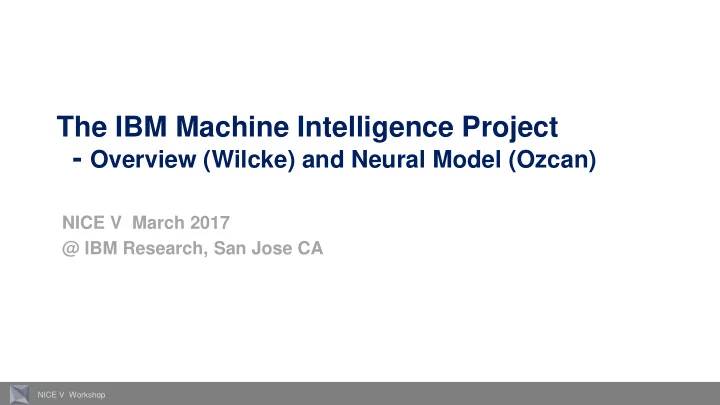

HAL 9000 The IBM Machine Intelligence Project - Overview (Wilcke) and Neural Model (Ozcan) NICE V March 2017 @ IBM Research, San Jose CA NICE V Workshop
Vision for Machine Intelligence Project (MI) Machines which will use fast associative reasoning to mimic human intelligence Machine Intelligence ( MI) operates very differently than Machine Learning ( ML) – We use the MI/ML terminology of Jeff Hawkins (Numenta) HAL 9000 NICE V Workshop IBM Machine Intelligence Project March 2017 2
Four interrelated Research Areas Biological & Neural Model Definition (2 nd half of this talk) Context Aware Learning (CAL) – Algorithms and Software Escape 9000 ‘Neural Supercomputer’ Roving Robots (KATE & Turtle-Bot) NICE V Workshop IBM Machine Intelligence Project March 2017 4
Key Concepts of Machine Intelligence Project Closely guided by neuroscience – not just “inspired” Unsupervised & continuous learning – via autonomous detection & prediction of spatio-temporal noisy patterns Autonomously build ‘world models’ – realize the model as hierarchies of Sparse Distributed Representations - SDR • 000000000000010000000101000000000000000000100000000000001000 – roving robots to get the data for building the world model Learning is mostly due to formation of new synapses (plastic topology) Feedback is very important NICE V Workshop IBM Machine Intelligence Project March 2017 5
Layer 1 Neocortex Layer 2/3 Layer 4 Mini-Column Layer 5 One Neuron Layer 6 NICE V Workshop March 2017 6
Too Simple Neural Hierarchy Sparse Distributed Pattern (“Representation”) of OUTPUTS: firing neurons Predictions Contexts SDR=SDR(time) Stable Concepts Motor commands INPUTS: Spatial- temporal data streams of any kind Array of columns of neurons aka “Sequence Memory” (J.Hawkins et.al.) one neuron NICE V Workshop IBM Machine Intelligence Project 7
Layers, Levels and Regions Regions are stacks of 5 neural “Layers” Outputs Multiple Regions form a “Level” Multiple Levels form a “Tree” (or other topology) System is a collection of these Trees – but see next slides Sensory Inputs associated a Region with one modality (e.g. vision) NICE V Workshop IBM Machine Intelligence Project February 2017 8
Thalamus – two important Functions Central router for: – communication between • regions to regions and to sensors & motors • local neural hierarchies – feedback between regions Blackboard for sharing data between regions NICE V Workshop IBM Machine Intelligence Project March 2017 9
Feedback through the Thalamus NICE V Workshop 10
The Importance of Feedback Prediction Error Text stream, with errors inserted Time NICE V Workshop IBM Machine Intelligence Project March 2017 11
Current Status… NICE V Workshop IBM Machine Intelligence Project March 2017 12
Baby CAL 2 regions on 2 levels sufficient to test key functions of CAL NICE V Workshop IBM Machine Intelligence Project March 2017 13
(Baby) CAL in four Video Demos (outside) ‘Correlator’ Video – Dynamic formation of synapses connecting neurons which are firing simultaneously due to correlated inputs Trajectory of chaotic oscillator 0.6 Input data Prediction ‘Sequence Memory’ Video 0.4 0.2 Velocity 0 – Prediction of phase-space behavior of a chaotic oscillator -0.2 -0.4 -0.6 -0.8 -0.6 -0.4 -0.2 0 0.2 0.4 0.6 0.8 Position ‘Temporal Pooler’ Video – Streaming text and persistent SDR(time) in upper Level 2 ‘Feedback’ Video – Streaming text, randomly damaged, is better predicted with feedback between Levels NICE V Workshop IBM Machine Intelligence Project March 2017 14
ESCAPE 9000 • The brain is an extremely connected system of strongly non-linear elements • There is no closed-form mathematics for such systems • Tens of thousands of numerical experiments required • Model plastic topology as software structures • We are building a new supercomputer for these experiments – ESCAPE 9000 • Very flexible and fast (1296 FPGA + 2592 ARM cores) • Very high bandwidth, TB of RAM • Scalable to even larger sizes and waferscale (SHANNON) • Already running CAL (see demo outside) NICE V Workshop IBM Machine Intelligence Project February 2017 15
Robots for Machine Intelligence We are building robots for several reasons – Demonstrate unsupervised learning – Build a world model – Gain experience with the sensory-motor loop Unsupervised Learning – Our two-legged robots have learned – on their own – to detect sensory anomalies and react to prevent falling – 1900 steps without falling World Model (future) – Use roving robots to learn facts about the world Anomaly Detection while walking NICE V Workshop IBM Machine Intelligence Project February 2017 16
The Path to Reasoning 1. Describe the world as billions of SDR’s in a neocortical forest of neural ‘trees’ plus the Thalamus structure 2. Exploit the semantic properties of SDR and the power of ESCAPE 9000 to quickly find associations, i.e. overlaps between SDRs – If it walks like a duck and looks like a duck and quacks like duck it probably is a duck ! NICE V Workshop IBM Machine Intelligence Project March 2017 17
Team Hernan Badenes Geoffrey Burr Ken Clarkson Chuck Cox Jacquana Diep Harald Huels Wayne Imaino Tomasz Kornuta Arvind Kumar Hyong-Euk Lee (Partner) Pritish Narayanan Ahmet Ozcan David Pease Kamil Rocki Campbell Scott Ryusei Shingaki (Partner) Jayram Thathachar Winfried Wilcke NICE V Workshop IBM Machine Intelligence Project March 2017 18
Thank you! Link to short video of Kate in Almaden Hallway http://acr044n01cmp.almaden.ibm.com:8000/#d=/demo-ch01&x=elapsedTime&y=meanSqrtErr_0 NICE V Workshop IBM Machine Intelligence Project March 2017 19
Recommend
More recommend